Polymer Zero-Order Quarter-Wave Plates

- True Zero-Order Quarter-Wave Plates
- Offered at Discrete Wavelengths Between 405 nm and 2700 nm
- Lower AOI Dependence than Quartz Wave Plates
- Available in 1/2", 1", and 2" Diameters
Edge Marking Indicates Fast Axis
WPQ10E-532
Ø1" Quarter-Wave Plate
for 532 nm
WPQ10ME-633
Mounted Ø1" Quarter-Wave
Plate for 633 nm
WPQ20ME-1550
Mounted Ø2" Quarter-Wave
Plate for 1550 nm
WPQ05ME-405
Ø1/2" Mounted Quarter-Wave Plate for 405 nm

Please Wait
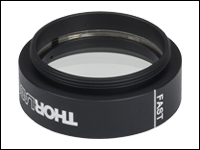
Click to Enlarge
The fast axis of the mounted Ø1/2", Ø1", and Ø2" wave plates is engraved on the side of the housing. Internal and external SM threads allow for easy integration with Thorlabs' SM-threaded components.
Features
- True Zero-Order Quarter-Wave Plates at Discrete Design Wavelengths from 405 nm to 2700 nm
- Mounted Ø1/2" Wave Plates
- Unmounted and Mounted Ø1" Wave Plates
- Mounted Ø2" Wave Plates*
- Excellent Performance at AOIs Up to 20° (See Graphs Below)
- Retardance Accuracy: <λ/100
- Retardance Uniformity:
- <5 nm (RMS) for 405 - 1650 nm
- <8.5 nm (RMS) for 1940 - 2700 nm
- Broadband AR Coating for ≥89% Transmission: 350 - 700 nm, 650 - 1050 nm, 1050 - 1700 nm, or 1650 - 3000 nm
- Polymer Zero-Order Half-Wave Plates Available
- Custom Wave Plates Available (See the Custom Capabilities Tab)
*For Design Wavelengths from 405 nm to 1650 nm
Thorlabs' Polymer Quarter-Wave Plates are fabricated from a liquid crystal polymer (LCP), which is laminated between two
N-BK7 or Suprasil-300 glass windows. The unmounted Ø1" version has the fast axis marked on the edge of the glass for ease of alignment. We also manufacture Ø1/2", Ø1", and Ø2" versions in an SM05-threaded (0.535"-40), SM1-threaded (1.035"-40), or SM2-threaded (2.035"-40) housing, respectively, which are engraved with the item number and the fast axis orientation. The mounted wave plates are epoxied into the housing; attempting to remove the wave plate from the housing may result in damage to the wave plate. The glass plates have a broadband AR coating for the 350 - 700 nm range, the 650 - 1050 nm range, the 1050 - 1700 nm range, or the 1650 - 3000 nm range deposited on the glass-to-air interfaces.
LCP wave plates are designed to be true zero-order wave plates, which can provide stable performance over a range of wavelengths and a large range of angles of incidence (AOI) (click on the ![]() icons below for retardance vs. wavelength plots). This design is advantageous for applications that require low sensitivity to AOI. A polymer wave plate can be used at an AOI up to 20° with only a 5% retardance decrease, compared to less than 2° for standard quartz wave plates (see graphs below). Additionally, due to a well established production process using spin coating, our polymer wave plates have excellent retardance uniformity across the large clear aperture with low optical losses and low wavefront distortion of <λ/4 at 633 nm.
icons below for retardance vs. wavelength plots). This design is advantageous for applications that require low sensitivity to AOI. A polymer wave plate can be used at an AOI up to 20° with only a 5% retardance decrease, compared to less than 2° for standard quartz wave plates (see graphs below). Additionally, due to a well established production process using spin coating, our polymer wave plates have excellent retardance uniformity across the large clear aperture with low optical losses and low wavefront distortion of <λ/4 at 633 nm.
These polymer wave plates can be mounted in Thorlabs' rotation mounts. Our polymer half-wave plates offer true zero-order retardance for rotating linear polarizations. Alternatively, we also offer mounted quartz zero-order quarter-wave plates and half-wave plates for applications that would benefit from a higher surface quality, increased retardance accuracy, smaller beam deviation, or a higher damage threshold.
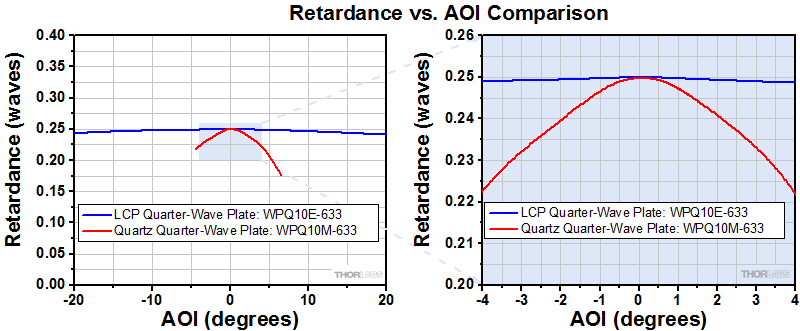
Click to Enlarge
The plot above shows a comparison between the performance of a WPH10M-633 quartz half-wave plate and a WPH10E-633 liquid crystal polymer half-wave plate with respect to angle of incidence. The true zero-order operation of the WPH10E-633 LCP half-wave plate provides a more stable retardance over a wider range of AOI in comparison to the compound zero-order WPH10M-633 quartz half-wave plate.
| Wave Plate Selection Guide | ||||||||||
|---|---|---|---|---|---|---|---|---|---|---|
| Achromatic | Superachromatic | Quartz Zero-Order Half-Wave |
Quartz Zero-Order Quarter-Wave |
Polymer Zero-Order Half-Wave |
Polymer Zero-Order Quarter-Wave |
Low-Order | Multi-Order | Dual Wavelength | Telecom | Polarization Optics |
| General Specificationsa | |||||||
|---|---|---|---|---|---|---|---|
| Wave Plate Diameter | 0.50" (12.7 mm) | 1.00" (25.4 mm) | 2.00" (50.8 mm) | ||||
| Clear Aperture | Ø0.38" (Ø9.8 mm) | Ø0.90" (Ø22.8 mm)b | Ø1.90" (Ø48.3 mm) | ||||
| Wave Plate Thicknessc | 2.0 mm (0.08") | 3.2 mm (0.13") | 6.4 mm (0.25") | ||||
| Design Wavelength | 405 - 1640 nm | 1940 - 2700 nm | 405 - 1640 nm | 1940 - 2700 nm | 405 - 1640 nm | ||
| Average Reflectanced (Per Coated Surface) |
<0.5% | <1.0% | <0.5% | <1.0% | <0.5% | ||
| Retardance | λ/4 @ Design Wavelength | ||||||
| Retardance Accuracye | <λ/100 @ Design Wavelength | ||||||
| Retardance Uniformity (RMS)e | <5 nm | <8.5 nm | <5 nm | <8.5 nm | <5 nm | ||
| Material | Liquid Crystal Polymer Between N-BK7 Glass Plates |
Liquid Crystal Polymer Between Suprasil-300 Glass Plates |
Liquid Crystal Polymer Between N-BK7 Glass Plates |
Liquid Crystal Polymer Between Suprasil-300 Glass Plates |
Liquid Crystal Polymer Between N-BK7 Glass Plates |
||
| Transmitted Wavefront Error | <λ/4 @ 633 nm | ||||||
| Surface Quality | 60-40 Scratch-Dig | ||||||
| Temperature Stabilityf | <(λ/5000)/°C @ Design Wavelength | ||||||
| Operating Temperature Range | -20 to 60 °C | ||||||
| Beam Deviation (Unmounted Wave Plates) | <5 arcmin | ||||||
| Beam Deviation (Mounted Wave Plates) | <20 arcmin | ||||||
Examples of Polymer Zero-Order Wave Plate Performance
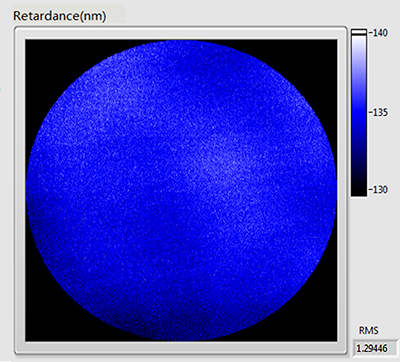
Click to Enlarge
Typical uniformity of retardation across the clear aperture of a Ø1" quarter-wave plate. The data above was obtained using the WPQ10E-532 wave plate. This screenshot shows an RMS retardance value of 1.29 nm.
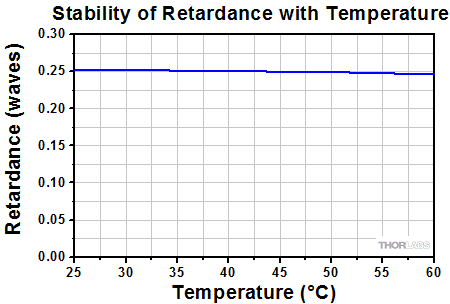
Click to Enlarge
The stability of retardance for the WPQ10E-633 LCP zero-order quarter-wave plate measured over a portion of the specified temperature range.
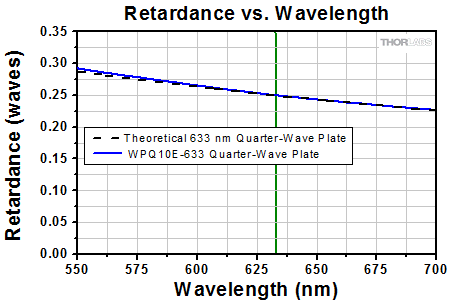
Click to Enlarge
An example of the dispersion performance of the LCP zero-order quarter-wave plate. The green line indicates the design wavelength of the WPQ10E-633 wave plate. The theoretical curve was calculated for a perfect 633 nm zero-order quarter-wave plate with no dispersion.
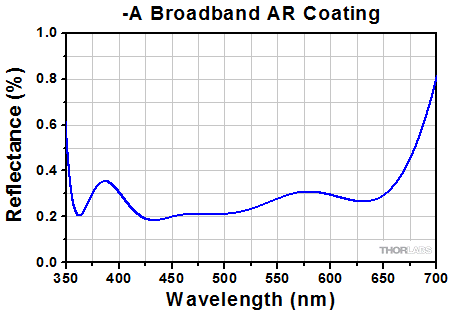
Click to Enlarge
Sample reflectance curve for Thorlabs' standard A coating, designed for <0.5% average reflectance over the 350 - 700 nm range.
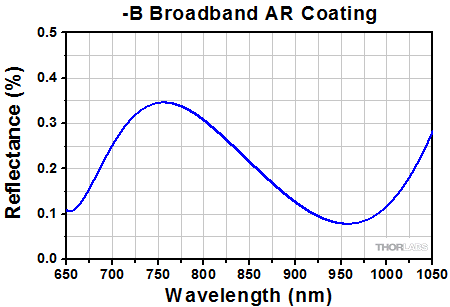
Click to Enlarge
Sample reflectance curve for Thorlabs' standard B coating, designed for <0.5% average reflectance over the 650 - 1050 nm range.
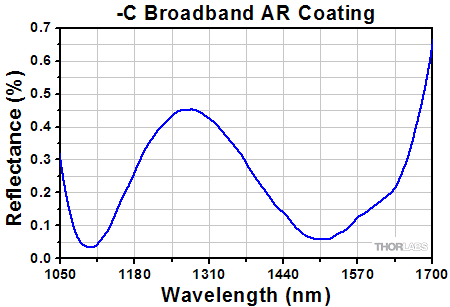
Click to Enlarge
Sample reflectance curve for Thorlabs' standard C coating, designed for <0.5% average reflectance over the 1050 - 1700 nm range.
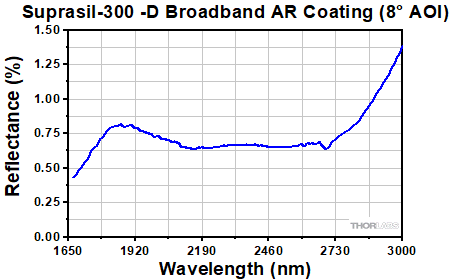
Click to Enlarge
Sample reflectance curve for Thorlabs' standard D coating, designed for <1.0% average reflectance over the 1650 - 3000 nm range.
Sample Transmittance Plots
The plots below show the measured transmittance of three example liquid crystal polymer (LCP) wave plates. The differences in transmittance are caused by the different AR coatings, and by the different materials used to align the polymers in the LCP retarding material of the wave plate. The shaded blue region of each graph represents the specified coating range.
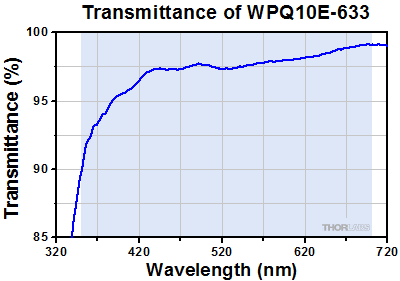
Click to Enlarge
The transmittance of the A-coated WPQ10E-633 wave plate. This curve is representative of the performance of our -405, -488, -514, -532, -546, -633, and -670 quarter-wave plates. The blue shaded region indicates the wavelength range over which the AR coating provides <0.5% average reflectance. Click here to download the data.
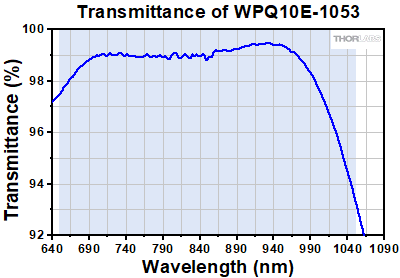
Click to Enlarge
The transmittance of the WPQ10E-1053 wave plate. This curve is representative of the performance of our -780, -808, -830, -980, and -1053 quarter-wave plates. The blue shaded region indicates the wavelength range over which the AR coating provides <0.5% average reflectance. Click here to download the data.
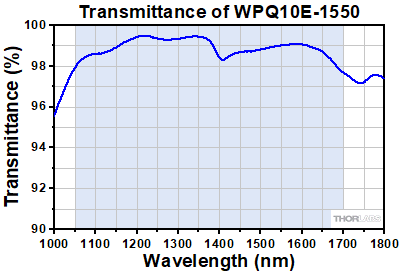
Click to Enlarge
The transmittance of the WPQ10E-1550 wave plate. This curve is representative of the performance of our -1064, -1310, -1550, -1625, -1650 quarter-wave plates. The blue shaded region indicates the wavelength range over which the AR coating provides <0.5% average reflectance. Click here to download the data.

Click to Enlarge
The transmittance of the WPQ10E-1940 wave plate. This curve is representative of the performance of our -1940, -2000, -2500, and -2700 quarter-wave plates. The blue shaded region indicates the wavelength range over which the AR coating provides <1.0% average reflectance. Click here to download the data.
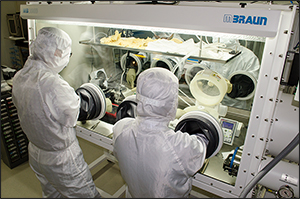
Click to Enlarge
Figure 1: Our highly trained engineers constructing and testing polymer wave plates.
Thorlabs offers a large variety of polymer wave plates with operating wavelengths from 405 nm to 2700 nm; diameters of 1/2" (12.7 mm), 1" (25.4 mm), or 2" (50.8 mm); in mounted or unmounted versions. In addition, we also offer OEM and custom polymer wave plates upon request. The target wavelength, retardance, coating, mechanical housing, and dimensions can be customized to meet unique optical designs.
Our engineers work directly with our customers to discuss the specifications and other design aspects of a custom polymer wave plate. We analyze both the design and feasibility to ensure the custom products are manufactured to highest quality standards and in a timely manner. For more information about ordering a custom polymer wave plate, please contact Tech Sales.
Photo-Alignment Material Coating and Alignment
Polymer Zero-Order Wave Plates utilize a liquid crystal polymer, similar to nematic liquid crystals, which requires the polymer molecules to be aligned. To accomplish this, an alignment layer is created by coating a substrate in photo-alignment material and exposing it to polarized laser light. A 20 to 30 nm layer of photo-alignment material is deposited on a glass substrate by spin coating (see Figure 2); it is then exposed to linearly polarized light, aligning the molecules in the coating to the polarization direction of the exposure light. This initial orientation can be set to any value to meet the customization requirements. Additionally, we can provide custom patterned wave plates/retarders (see the Patterned Retarders tab for more information).
Custom Retardance
The retardance of a polymer wave plate is determined by the thickness of a layer of cured liquid crystal polymer. This layer is coated on the top of the alignment material using a spin coating technique, enabling precise control of the layer’s thickness. Our stock polymer wave plates cover many of the common wavelengths; custom wavelengths between 400 to 2700 nm can be special ordered as well.
Custom Size and Mounting Options
We offer SM05-mounted Ø1/2", unmounted Ø1", SM1-mounted Ø1", and SM2-mounted Ø2" wave plates from stock. Our custom waveplates are available in sizes ranging from Ø1/2" to Ø2" and can be ordered either mounted or unmounted.
Testing
Each polymer wave plate is tested for birefringence, uniformity, and fast axis angle. An imaging polarimeter measures the 2-dimensional birefringence distribution across the wave plate's face. Figures 3 and 4 show testing rigs for our polymer wave plates.
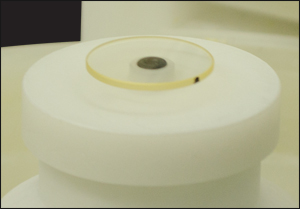
Click for Details
Figure 2: A glass substrate mounted on the spin coating machine ready to be coated with the photo alignment material.
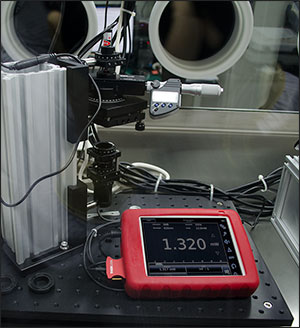
Click to Enlarge
Figure 3: The test setup for measuring the retardance through a polymer wave plate.
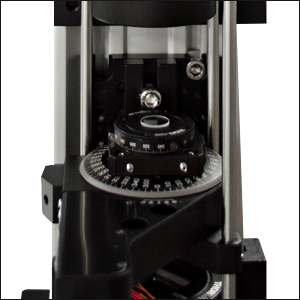
Click for Details
Figure 4: The test setup for checking the retardance and alignment uniformity of our polymer wave plates.
| Custom Capability | Custom Specification |
|---|---|
| Patterned Retarder Size | Ø100 µm to Ø2" |
| Patterned Retarder Shape | Any |
| Microretarder Size | ≥Ø30 µm |
| Microretarder Shape | Round or Square |
| Retardance Range @ 632.8 nm | 50 to 550 nm |
| Substrate | N-BK7, UV Fused Silica, or Other Glass |
| Substrate Size | Ø5 mm to Ø2" |
| AR Coating | -A: 350 - 700 nm -B: 650 - 1050 nm -C: 1050 - 1700 nm |
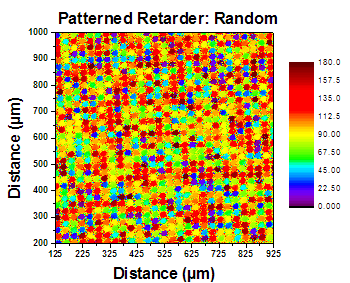
Click to Enlarge
Figure 1: Patterned Retarder with Random Distribution
Features
- Build a Custom Microretarder
- Customize Size, Shape, and Substrate Material
- Retardance Range: 50 - 550 nm
- Fast Axis Resolution: <1º
- Retardance Fluctuations Under 30 nm
Applications
- 3D Displays
- Polarization Imaging
- Diffractive Optical Applications: Polarization Gratings, Polarimetry, and Beam Steering
Thorlabs offers customizable patterned retarders, available in any pattern size from Ø100 µm to Ø2" and any substrate size from Ø5 mm to Ø2". These custom retarders are composed of an array of microretarders, each of which has a fast axis aligned to a different angle than its neighbor. The size and shape of the microretarders are also customizable. They can be as small as 30 µm and in shapes including circles and squares. This control over size and shape of the individual microretarders allows us to construct a large array of various patterned retarders to meet nearly any experimental or device need.
These patterned retarders are constructed from our liquid crystals and liquid crystal polymers. Using photo alignment technology, we can secure the fast axis of each microretarder to any angle within a resolution of <1°. Figures 1 - 3 show examples of our patterned retarders. The figures represent measured results of the patterned retarder captured on an imaging polarimeter and demonstrate that the fast axis orientation of any one individual microretarder can be controlled deterministically and separately from its neighbors.
The manufacturing process for our patterned retarders is controlled completely in house. It begins by preparing the substrate, which is typically N-BK7 or UV fused silica (although other glass substrates may be compatible as well). The substrate is then coated with a layer of photoalignment material and placed in our patterned retarder system where sections are exposed to linearly polarized light to set the fast axis of a microretarder. The area of the exposed sections depends on the desired size of the microretarder; the fast axis can be set between 0° and 180° with a resolution <1°. Once set, the liquid crystal cell is constructed by coating the device with a liquid crystal polymer and curing it with UV light.
Thorlabs' LCP depolarizers provide one example of these patterned retarders. In principle, a truly randomized pattern may be used as a depolarizer, since it scrambles the input polarization spatially. However, such a pattern will also introduce a large amount of diffraction. For our depolarizers, we designed a linearly ramping fast axis angle and retardance that can depolarize both broadband and monochromatic beams down to diameters of 0.5 mm without introducing additional diffraction. For more details, see the webpage for our LCP depolarizers.
By supplying Thorlabs with a drawing of the desired patterned retarder or an excel file of the fast axis distribution, we can construct almost any patterned retarder. For more information on creating a patterned retarder, please contact Tech Support.
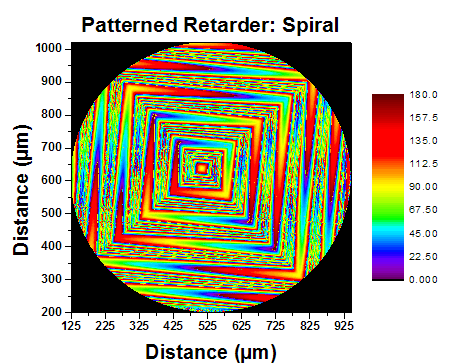
Click to Enlarge
Figure 2: Patterned Retarder with a Spiral Distribution
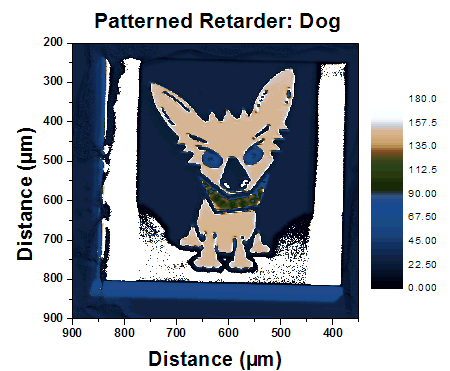
Click to Enlarge
Figure 3: Patterned Retarder with a Pictoral Distribution
| Damage Threshold Specifications | ||
|---|---|---|
| Item # Suffix | Laser Type | Damage Threshold |
| -405 | CW | 5 W/cm (532 nm, CW, Ø0.0107 mm)a |
| Pulsed (ns) | 0.15 J/cm2 (532 nm, 10 ns, 10 Hz, Ø0.597 mm) | |
| Pulsed (fs) | 0.023 J/cm2 (532 nm, 100 Hz, 76 fs, Ø162 µm) | |
| -488 to 670 |
CW | 5 W/cm (810 nm, CW, Ø0.004 mm)a |
| Pulsed (ns) | 1.8 J/cm2 (532 nm, 8 ns, 10 Hz, Ø0.200 mm) | |
| Pulsed (fs) | 0.041 J/cm2 (532 nm, 100 Hz, 76 fs, Ø162 µm) | |
| -780 to 1030 | CW | 5 W/cm (810 nm, CW, Ø0.004 mm)a |
| Pulsed (ns) | 8 J/cm2 (810 nm, 10 ns, 10 Hz, Ø0.08 mm) | |
| Pulsed (fs) | 0.041 J/cm2 (800 nm, 100 Hz, 36.4 fs, Ø189 µm) | |
| -1053 to 1650 | CW | 5 W/cm (810 nm, CW, Ø0.004 mm)a |
| Pulsed (ns) | 10 J/cm2 (1550 nm, 7.8 ns, 10 Hz, Ø0.191 mm) | |
| Pulsed (fs) | 0.11 J/cm2 (1550 nm, 100 Hz, 70 fs, Ø145 µm) | |
Damage Threshold Data for Thorlabs' LCP Wave Plates
The specifications to the right are measured data for Thorlabs' LCP wave plates. Damage threshold specifications are constant for all of the wave plates with the same design wavelength, regardless of the size of the optic.
Laser Induced Damage Threshold Tutorial
The following is a general overview of how laser induced damage thresholds are measured and how the values may be utilized in determining the appropriateness of an optic for a given application. When choosing optics, it is important to understand the Laser Induced Damage Threshold (LIDT) of the optics being used. The LIDT for an optic greatly depends on the type of laser you are using. Continuous wave (CW) lasers typically cause damage from thermal effects (absorption either in the coating or in the substrate). Pulsed lasers, on the other hand, often strip electrons from the lattice structure of an optic before causing thermal damage. Note that the guideline presented here assumes room temperature operation and optics in new condition (i.e., within scratch-dig spec, surface free of contamination, etc.). Because dust or other particles on the surface of an optic can cause damage at lower thresholds, we recommend keeping surfaces clean and free of debris. For more information on cleaning optics, please see our Optics Cleaning tutorial.
Testing Method
Thorlabs' LIDT testing is done in compliance with ISO/DIS 11254 and ISO 21254 specifications.
First, a low-power/energy beam is directed to the optic under test. The optic is exposed in 10 locations to this laser beam for 30 seconds (CW) or for a number of pulses (pulse repetition frequency specified). After exposure, the optic is examined by a microscope (~100X magnification) for any visible damage. The number of locations that are damaged at a particular power/energy level is recorded. Next, the power/energy is either increased or decreased and the optic is exposed at 10 new locations. This process is repeated until damage is observed. The damage threshold is then assigned to be the highest power/energy that the optic can withstand without causing damage. A histogram such as that below represents the testing of one BB1-E02 mirror.

The photograph above is a protected aluminum-coated mirror after LIDT testing. In this particular test, it handled 0.43 J/cm2 (1064 nm, 10 ns pulse, 10 Hz, Ø1.000 mm) before damage.

| Example Test Data | |||
|---|---|---|---|
| Fluence | # of Tested Locations | Locations with Damage | Locations Without Damage |
| 1.50 J/cm2 | 10 | 0 | 10 |
| 1.75 J/cm2 | 10 | 0 | 10 |
| 2.00 J/cm2 | 10 | 0 | 10 |
| 2.25 J/cm2 | 10 | 1 | 9 |
| 3.00 J/cm2 | 10 | 1 | 9 |
| 5.00 J/cm2 | 10 | 9 | 1 |
According to the test, the damage threshold of the mirror was 2.00 J/cm2 (532 nm, 10 ns pulse, 10 Hz, Ø0.803 mm). Please keep in mind that these tests are performed on clean optics, as dirt and contamination can significantly lower the damage threshold of a component. While the test results are only representative of one coating run, Thorlabs specifies damage threshold values that account for coating variances.
Continuous Wave and Long-Pulse Lasers
When an optic is damaged by a continuous wave (CW) laser, it is usually due to the melting of the surface as a result of absorbing the laser's energy or damage to the optical coating (antireflection) [1]. Pulsed lasers with pulse lengths longer than 1 µs can be treated as CW lasers for LIDT discussions.
When pulse lengths are between 1 ns and 1 µs, laser-induced damage can occur either because of absorption or a dielectric breakdown (therefore, a user must check both CW and pulsed LIDT). Absorption is either due to an intrinsic property of the optic or due to surface irregularities; thus LIDT values are only valid for optics meeting or exceeding the surface quality specifications given by a manufacturer. While many optics can handle high power CW lasers, cemented (e.g., achromatic doublets) or highly absorptive (e.g., ND filters) optics tend to have lower CW damage thresholds. These lower thresholds are due to absorption or scattering in the cement or metal coating.

LIDT in linear power density vs. pulse length and spot size. For long pulses to CW, linear power density becomes a constant with spot size. This graph was obtained from [1].

Pulsed lasers with high pulse repetition frequencies (PRF) may behave similarly to CW beams. Unfortunately, this is highly dependent on factors such as absorption and thermal diffusivity, so there is no reliable method for determining when a high PRF laser will damage an optic due to thermal effects. For beams with a high PRF both the average and peak powers must be compared to the equivalent CW power. Additionally, for highly transparent materials, there is little to no drop in the LIDT with increasing PRF.
In order to use the specified CW damage threshold of an optic, it is necessary to know the following:
- Wavelength of your laser
- Beam diameter of your beam (1/e2)
- Approximate intensity profile of your beam (e.g., Gaussian)
- Linear power density of your beam (total power divided by 1/e2 beam diameter)
Thorlabs expresses LIDT for CW lasers as a linear power density measured in W/cm. In this regime, the LIDT given as a linear power density can be applied to any beam diameter; one does not need to compute an adjusted LIDT to adjust for changes in spot size, as demonstrated by the graph to the right. Average linear power density can be calculated using the equation below.

The calculation above assumes a uniform beam intensity profile. You must now consider hotspots in the beam or other non-uniform intensity profiles and roughly calculate a maximum power density. For reference, a Gaussian beam typically has a maximum power density that is twice that of the uniform beam (see lower right).
Now compare the maximum power density to that which is specified as the LIDT for the optic. If the optic was tested at a wavelength other than your operating wavelength, the damage threshold must be scaled appropriately. A good rule of thumb is that the damage threshold has a linear relationship with wavelength such that as you move to shorter wavelengths, the damage threshold decreases (i.e., a LIDT of 10 W/cm at 1310 nm scales to 5 W/cm at 655 nm):

While this rule of thumb provides a general trend, it is not a quantitative analysis of LIDT vs wavelength. In CW applications, for instance, damage scales more strongly with absorption in the coating and substrate, which does not necessarily scale well with wavelength. While the above procedure provides a good rule of thumb for LIDT values, please contact Tech Support if your wavelength is different from the specified LIDT wavelength. If your power density is less than the adjusted LIDT of the optic, then the optic should work for your application.
Please note that we have a buffer built in between the specified damage thresholds online and the tests which we have done, which accommodates variation between batches. Upon request, we can provide individual test information and a testing certificate. The damage analysis will be carried out on a similar optic (customer's optic will not be damaged). Testing may result in additional costs or lead times. Contact Tech Support for more information.
Pulsed Lasers
As previously stated, pulsed lasers typically induce a different type of damage to the optic than CW lasers. Pulsed lasers often do not heat the optic enough to damage it; instead, pulsed lasers produce strong electric fields capable of inducing dielectric breakdown in the material. Unfortunately, it can be very difficult to compare the LIDT specification of an optic to your laser. There are multiple regimes in which a pulsed laser can damage an optic and this is based on the laser's pulse length. The highlighted columns in the table below outline the relevant pulse lengths for our specified LIDT values.
Pulses shorter than 10-9 s cannot be compared to our specified LIDT values with much reliability. In this ultra-short-pulse regime various mechanics, such as multiphoton-avalanche ionization, take over as the predominate damage mechanism [2]. In contrast, pulses between 10-7 s and 10-4 s may cause damage to an optic either because of dielectric breakdown or thermal effects. This means that both CW and pulsed damage thresholds must be compared to the laser beam to determine whether the optic is suitable for your application.
| Pulse Duration | t < 10-9 s | 10-9 < t < 10-7 s | 10-7 < t < 10-4 s | t > 10-4 s |
|---|---|---|---|---|
| Damage Mechanism | Avalanche Ionization | Dielectric Breakdown | Dielectric Breakdown or Thermal | Thermal |
| Relevant Damage Specification | No Comparison (See Above) | Pulsed | Pulsed and CW | CW |
When comparing an LIDT specified for a pulsed laser to your laser, it is essential to know the following:

LIDT in energy density vs. pulse length and spot size. For short pulses, energy density becomes a constant with spot size. This graph was obtained from [1].
- Wavelength of your laser
- Energy density of your beam (total energy divided by 1/e2 area)
- Pulse length of your laser
- Pulse repetition frequency (prf) of your laser
- Beam diameter of your laser (1/e2 )
- Approximate intensity profile of your beam (e.g., Gaussian)
The energy density of your beam should be calculated in terms of J/cm2. The graph to the right shows why expressing the LIDT as an energy density provides the best metric for short pulse sources. In this regime, the LIDT given as an energy density can be applied to any beam diameter; one does not need to compute an adjusted LIDT to adjust for changes in spot size. This calculation assumes a uniform beam intensity profile. You must now adjust this energy density to account for hotspots or other nonuniform intensity profiles and roughly calculate a maximum energy density. For reference a Gaussian beam typically has a maximum energy density that is twice that of the 1/e2 beam.
Now compare the maximum energy density to that which is specified as the LIDT for the optic. If the optic was tested at a wavelength other than your operating wavelength, the damage threshold must be scaled appropriately [3]. A good rule of thumb is that the damage threshold has an inverse square root relationship with wavelength such that as you move to shorter wavelengths, the damage threshold decreases (i.e., a LIDT of 1 J/cm2 at 1064 nm scales to 0.7 J/cm2 at 532 nm):

You now have a wavelength-adjusted energy density, which you will use in the following step.
Beam diameter is also important to know when comparing damage thresholds. While the LIDT, when expressed in units of J/cm², scales independently of spot size; large beam sizes are more likely to illuminate a larger number of defects which can lead to greater variances in the LIDT [4]. For data presented here, a <1 mm beam size was used to measure the LIDT. For beams sizes greater than 5 mm, the LIDT (J/cm2) will not scale independently of beam diameter due to the larger size beam exposing more defects.
The pulse length must now be compensated for. The longer the pulse duration, the more energy the optic can handle. For pulse widths between 1 - 100 ns, an approximation is as follows:

Use this formula to calculate the Adjusted LIDT for an optic based on your pulse length. If your maximum energy density is less than this adjusted LIDT maximum energy density, then the optic should be suitable for your application. Keep in mind that this calculation is only used for pulses between 10-9 s and 10-7 s. For pulses between 10-7 s and 10-4 s, the CW LIDT must also be checked before deeming the optic appropriate for your application.
Please note that we have a buffer built in between the specified damage thresholds online and the tests which we have done, which accommodates variation between batches. Upon request, we can provide individual test information and a testing certificate. Contact Tech Support for more information.
[1] R. M. Wood, Optics and Laser Tech. 29, 517 (1998).
[2] Roger M. Wood, Laser-Induced Damage of Optical Materials (Institute of Physics Publishing, Philadelphia, PA, 2003).
[3] C. W. Carr et al., Phys. Rev. Lett. 91, 127402 (2003).
[4] N. Bloembergen, Appl. Opt. 12, 661 (1973).
In order to illustrate the process of determining whether a given laser system will damage an optic, a number of example calculations of laser induced damage threshold are given below. For assistance with performing similar calculations, we provide a spreadsheet calculator that can be downloaded by clicking the button to the right. To use the calculator, enter the specified LIDT value of the optic under consideration and the relevant parameters of your laser system in the green boxes. The spreadsheet will then calculate a linear power density for CW and pulsed systems, as well as an energy density value for pulsed systems. These values are used to calculate adjusted, scaled LIDT values for the optics based on accepted scaling laws. This calculator assumes a Gaussian beam profile, so a correction factor must be introduced for other beam shapes (uniform, etc.). The LIDT scaling laws are determined from empirical relationships; their accuracy is not guaranteed. Remember that absorption by optics or coatings can significantly reduce LIDT in some spectral regions. These LIDT values are not valid for ultrashort pulses less than one nanosecond in duration.

A Gaussian beam profile has about twice the maximum intensity of a uniform beam profile.
CW Laser Example
Suppose that a CW laser system at 1319 nm produces a 0.5 W Gaussian beam that has a 1/e2 diameter of 10 mm. A naive calculation of the average linear power density of this beam would yield a value of 0.5 W/cm, given by the total power divided by the beam diameter:

However, the maximum power density of a Gaussian beam is about twice the maximum power density of a uniform beam, as shown in the graph to the right. Therefore, a more accurate determination of the maximum linear power density of the system is 1 W/cm.
An AC127-030-C achromatic doublet lens has a specified CW LIDT of 350 W/cm, as tested at 1550 nm. CW damage threshold values typically scale directly with the wavelength of the laser source, so this yields an adjusted LIDT value:

The adjusted LIDT value of 350 W/cm x (1319 nm / 1550 nm) = 298 W/cm is significantly higher than the calculated maximum linear power density of the laser system, so it would be safe to use this doublet lens for this application.
Pulsed Nanosecond Laser Example: Scaling for Different Pulse Durations
Suppose that a pulsed Nd:YAG laser system is frequency tripled to produce a 10 Hz output, consisting of 2 ns output pulses at 355 nm, each with 1 J of energy, in a Gaussian beam with a 1.9 cm beam diameter (1/e2). The average energy density of each pulse is found by dividing the pulse energy by the beam area:

As described above, the maximum energy density of a Gaussian beam is about twice the average energy density. So, the maximum energy density of this beam is ~0.7 J/cm2.
The energy density of the beam can be compared to the LIDT values of 1 J/cm2 and 3.5 J/cm2 for a BB1-E01 broadband dielectric mirror and an NB1-K08 Nd:YAG laser line mirror, respectively. Both of these LIDT values, while measured at 355 nm, were determined with a 10 ns pulsed laser at 10 Hz. Therefore, an adjustment must be applied for the shorter pulse duration of the system under consideration. As described on the previous tab, LIDT values in the nanosecond pulse regime scale with the square root of the laser pulse duration:

This adjustment factor results in LIDT values of 0.45 J/cm2 for the BB1-E01 broadband mirror and 1.6 J/cm2 for the Nd:YAG laser line mirror, which are to be compared with the 0.7 J/cm2 maximum energy density of the beam. While the broadband mirror would likely be damaged by the laser, the more specialized laser line mirror is appropriate for use with this system.
Pulsed Nanosecond Laser Example: Scaling for Different Wavelengths
Suppose that a pulsed laser system emits 10 ns pulses at 2.5 Hz, each with 100 mJ of energy at 1064 nm in a 16 mm diameter beam (1/e2) that must be attenuated with a neutral density filter. For a Gaussian output, these specifications result in a maximum energy density of 0.1 J/cm2. The damage threshold of an NDUV10A Ø25 mm, OD 1.0, reflective neutral density filter is 0.05 J/cm2 for 10 ns pulses at 355 nm, while the damage threshold of the similar NE10A absorptive filter is 10 J/cm2 for 10 ns pulses at 532 nm. As described on the previous tab, the LIDT value of an optic scales with the square root of the wavelength in the nanosecond pulse regime:

This scaling gives adjusted LIDT values of 0.08 J/cm2 for the reflective filter and 14 J/cm2 for the absorptive filter. In this case, the absorptive filter is the best choice in order to avoid optical damage.
Pulsed Microsecond Laser Example
Consider a laser system that produces 1 µs pulses, each containing 150 µJ of energy at a repetition rate of 50 kHz, resulting in a relatively high duty cycle of 5%. This system falls somewhere between the regimes of CW and pulsed laser induced damage, and could potentially damage an optic by mechanisms associated with either regime. As a result, both CW and pulsed LIDT values must be compared to the properties of the laser system to ensure safe operation.
If this relatively long-pulse laser emits a Gaussian 12.7 mm diameter beam (1/e2) at 980 nm, then the resulting output has a linear power density of 5.9 W/cm and an energy density of 1.2 x 10-4 J/cm2 per pulse. This can be compared to the LIDT values for a WPQ10E-980 polymer zero-order quarter-wave plate, which are 5 W/cm for CW radiation at 810 nm and 5 J/cm2 for a 10 ns pulse at 810 nm. As before, the CW LIDT of the optic scales linearly with the laser wavelength, resulting in an adjusted CW value of 6 W/cm at 980 nm. On the other hand, the pulsed LIDT scales with the square root of the laser wavelength and the square root of the pulse duration, resulting in an adjusted value of 55 J/cm2 for a 1 µs pulse at 980 nm. The pulsed LIDT of the optic is significantly greater than the energy density of the laser pulse, so individual pulses will not damage the wave plate. However, the large average linear power density of the laser system may cause thermal damage to the optic, much like a high-power CW beam.
Insights into Polarization
Scroll down to read about:
- Create Circularly Polarized Light Using a Quarter-Wave Plate
Click here for more insights into lab practices and equipment.
Create Circularly Polarized Light Using a Quarter-Wave Plate
Circularly polarized light can be generated by placing a quarter-wave plate in a linearly polarized beam, provided a couple of conditions are met. The first is that the light's wavelength falls within the wave plate's operating range. The second is that the wave plate's slow and fast axes, which are orthogonal, are oriented at 45° to the direction of the linear polarization state. When this is true, the incident light has equal-magnitude components parallel to the wave plate's two axes. The wave plate delays the component parallel to the slow axis by a quarter of the light's wavelength ( /2) with respect to the component parallel to the fast axis. By creating this delay, the wave plate converts the polarization state from linear to circular.
/2) with respect to the component parallel to the fast axis. By creating this delay, the wave plate converts the polarization state from linear to circular.
An animation at the beginning of the demonstration illustrates the results of aligning the input linear polarization state with the wave plate's fast axis, slow axis, and angles in between. The perspective used to describe the angles and orientations is looking into the source, opposite the direction of light propagation. The procedure is then demonstrated for orienting input and output polarizers to define the reference orthogonal polarization directions, as well as provide polarization-dependent power measurements. The wave plate is placed between the two polarizers, and the effects of different orientations are explored. The quality of the circularly polarized light output by the wave plate is checked by rotating the second polarizer's transmission axis. The light's polarization is closer to circular when the power reading fluctuates less during rotation.
If you would like more information about tips, tricks, and other methods we often use in the lab, we recommend our other Video Insights. In addition, our webinars provide practical and theoretical introductions to our different products.
| Products Featured During Demonstration | ||||
|---|---|---|---|---|
| HeNe Laser | Quarter-Wave Plate | Precision Rotation Mounts | Power Sensor | Power Meter |
| Optical Isolator (for HeNe) | Linear Film Polarizers | V-Clamp Mount | SM1 Thread Adapter (for Power Sensor) | SM1 Lens Tube |
Date of Last Edit: Dec. 30, 2020
| Posted Comments: | |
Kent Ramthun
(posted 2024-02-23 10:10:40.46) We need a 900nm waveplate with 1/4 wave retardance. You do not offer this as a product. Can you please assess your ability to fabricate a zero-order waveplate at 900nm? We plan to go into production on a system that needs this type of waveplate, production is planned for 2026 - 2027. The immediate need is 5 pcs, with 10 - 20 pcs needed by fall/winter 2024/2025. It is expected production volumes will be 50-100pcs per month and will continue for 30 years. Let me know if this is of interest. We also need the waveplate thin, is it possible to coat only 1 pc of glass with the LC polymer and not sandwich between 2 pieces? Of course, the glass would have an AR coating at 900nm. Let me know the anticipated transmission loss with the LC polymer being uncoated. Looking for 60/40 scratch/dig and 1/2 wave transmitted wavefront. cdolbashian
(posted 2024-03-05 02:25:10.0) Thank you for reaching out to us with this inquiry. It is indeed possible to provide quarter wave plates at 900nm. Additionally, Glass substrate coated with a single layer of LC polymer is also feasible, and the rough transmission data for the non-AR coated version is >95%@900nm. I have contacted you directly to discuss more specifics regarding this custom. Zhangyan Li
(posted 2024-02-20 11:24:42.783) I want to buy some optical elements such as WPQ20ME-830 (2) , SBC-IR, please show me how to do. cdolbashian
(posted 2024-02-23 02:34:21.0) Thank you for contacting Thorlabs! Our sales colleagues will contact you directly for your requirements. Zhuoqun Dai
(posted 2022-06-27 08:05:23.847) Dear Thorlabs,
i would like to use a Ø2" Polymer Zero-Order Quarter-Wave Plate for a 940 nm Lasersource. is that possible to use the WPQ20ME-980 or do I need to customize a new one with a design wavelength of 940 nm?
hope for your feedback
best regards
Zhuoqun Dai cdolbashian
(posted 2022-07-06 11:26:27.0) Thank you for contacting Thorlabs. The retardance of the WPQ20ME-980 at 940 nm is ~0.26 waves (theoretical value), the waveplate can still be considered a quarter waveplate to some extent. Since 940 nm is not the design wavelength, the performance cannot be guaranteed. If you would like a waveplate with design wavelength of 940nm, custom optics can be requested by emailing your local Thorlabs Tech Support group (in your case, Europe@thorlabs.com). Neil Kad
(posted 2019-04-30 12:09:53.087) We ordered a quarter wave plate and it deviates the incident beam at an angle such that it no longer emerges parallel to the incident beam. This means that rotation of the plate leads to a beam orbit, making alignment impossible. Can we exchange this optic for one without such a problem? YLohia
(posted 2019-05-03 02:07:33.0) Hello, thank you for your feedback. Please accept our apologies for any issues caused by this. How much of a beam walk are you seeing? A certain amount of beam walk or deviation is normal and can be attributed to the the optic mounting, motion of the mechanics, and the parallelism of the optic. Optic mounting can play a large role in the deviation of the beam and such issues can be alleviated with the use of a tip-tilt rotation mount. Assuming mounting is not the problem here, we believe that the parallelism (which is specified to be <20 arcmin) would be the cause. We have reached out to you directly to gather more details and discuss a return. For better performance, we recommend our quartz waveplates whose beam deviation is <10 arcsec. We are also currently working on improving our web presentation to include beam deviation specs for these optics to allow our customers to find a better fit for their application. Alexander Graf
(posted 2019-03-14 02:39:26.31) I would need unmounted 1/2" Polymer quarter-wave plates (WPQ05ME-514). Is that possible? nbayconich
(posted 2019-03-15 08:24:18.0) Thank you for contacting Thorlabs. We can provide these, I will reach out to you directly to provide a quote. steveatalice
(posted 2018-04-07 07:29:15.403) I would like to obtain the unmounted optic out of WPQ05ME-830. Apparently I cannot remove it myself because it is glued into the aluminum ring. Is there any chance I can get 2 of these polymer waveplates without the metal mount? I might use 10 optics eventually if the first 2 work OK. Your current mount is too big to fit in my application. nbayconich
(posted 2018-04-09 09:16:25.0) Thank you for contacting Thorlabs. We can provide these waveplates un-mounted. I will contact you directly with more information. christian.schmidt
(posted 2017-10-04 10:33:14.017) I am looking for a big wave plate with a clear appreature of at least 50mm in diameter (or 35mm squared). Is it possible to obtain such a device? nbayconich
(posted 2017-10-04 05:11:03.0) Thank you for contacting Thorlabs. I will reach out to you directly about our custom capabilities. |
Choosing a Wave Plate
Thorlabs offers achromatic, superachromatic, zero-order (both unmounted wave plates and mounted wave plates), low-order, and multi-order wave plates (single wavelength and dual wavelength) with either λ/4 or λ/2 phase shift.
Achromatic Wave Plates provide phase retardance that is relatively independent of wavelength over a wide spectral range, and Superachromatic Wave Plates provide phase retardance almost entirely independent of wavelength over a much wider range than achromatic wave plates. In contrast, zero-order and multi-order wave plates provide a phase shift that is strongly wavelength dependent. Our achromatic wave plates are available with four operating ranges: 260 - 410 nm, 350 - 850 nm, 400 - 800 nm, 690 - 1200 nm, and 1100 - 2000 nm. Additionally, we offer superachromatic wave plates for the 310 - 1100 nm and 600 - 2700 nm ranges.
| Round Zero-Order Wave Plate Comparison | ||
|---|---|---|
| Material | Quartz | LCP |
| Sizes | Ø1/2" and Ø1" | Ø1/2", Ø1", and Ø2" |
| Mounted Versions Available | Yes | Yes |
| Retardances Available | 1/4 λ and 1/2 λ | 1/4 λ and 1/2 λ |
| Retardance Accuracy | <λ/300 | <λ/100 |
| Surface Quality | 20-10 Scratch-Dig | 60-40 Scratch-Dig |
| Coating | V Coat | Broadband AR |
| Coating Reflectance (per Surface) |
0.25% | <1.0% Average Over Specified Coating Range |
Zero-order wave plates are designed such that the phase shift created is exactly one quarter or one half of a wave. They offer substantially lower dependence on temperature and wavelength than multi-order wave plates. Our Zero-Order Quartz Half-Wave and Quarter-Wave Plates are composed of two wave plates stacked together with the fast axis of one aligned to the slow axis of the other to achieve zero-order performance. Thorlabs' zero-order wave plates are available for a number of discrete wavelengths ranging from 266 nm to 2020 nm. Our Polymer Zero-Order Half-Wave and Quarter-Wave Plates consist of a thin layer of liquid crystal polymer retarding material sandwiched between two glass plates and are available at discrete wavelengths between 405 nm and 2700 nm. Our quartz zero-order wave plates provide better retardance accuracy and lower reflectance (see table), while our LCP zero-order wave plates produce a smaller decrease in retardance at larger AOIs. In addition, Thorlabs also offers unmounted true Zero-Order Telecom Wave Plates for WDM applications.
MIR Wave Plates are made from a single piece of high-quality magnesium fluoride and provide either quarter-wave or half-wave retardance at 2.5 µm, 2.713 µm, 2.94 µm, 3.5 µm, 4.0 µm, 4.5 µm, or 5.3 µm. Light passing through these MIR wave plates will undergo a low number of full or partial wavelength shifts (also referred to as the order, or m) in addition to the fractional design retardance. This differs from true zero-order and multi-order wave plates which undergo no shift or a high number of shifts, respectively. The low-order design maintains near to true zero-order performance, making it a good alternative to true zero-order wave plates. The single magnesium fluoride substrate is also thinner compared to a zero-order design, which combines two multi-order wave plates, making our low-order retarders well suited for applications that are sensitive to dispersion.
Multi-Order Wave Plates are made such that the retardance of a light path will undergo a certain number of full wavelength shifts (also referred to as the order, or m) in addition to the fractional design retardance. Compared to their zero-order counterparts, the retardance of multi-order wave plates is more sensitive to wavelength and temperature changes. Multi-order wave plates are, however, a more economical solution for many applications where increased sensitivities are not an issue. Our multi-order wave plates are available for a number of discrete wavelengths ranging from 405 nm to 1550 nm. Thorlabs also offers Dual-Wavelength Multi-Order Wave Plates designed for use at both 532 nm and 1064 nm.
In addition to these options, Thorlabs also has the ability to design and manufacture custom wave plates for both OEM sales and individual low quantity orders. Our technical staff is able to help with all phases of your request: quoting, sales, and planning and manufacturing support. If you have a custom request or a question about our capabilities, please contact Tech Support to start a discussion.



 Products Home
Products Home











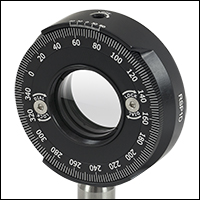


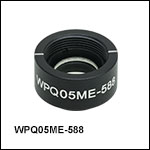
 Zoom
Zoom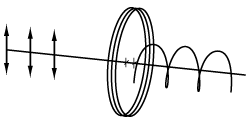
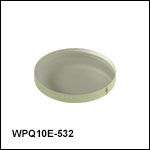
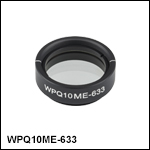
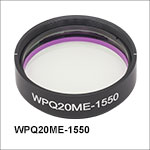
 Polymer Zero-Order Quarter-Wave Plates
Polymer Zero-Order Quarter-Wave Plates